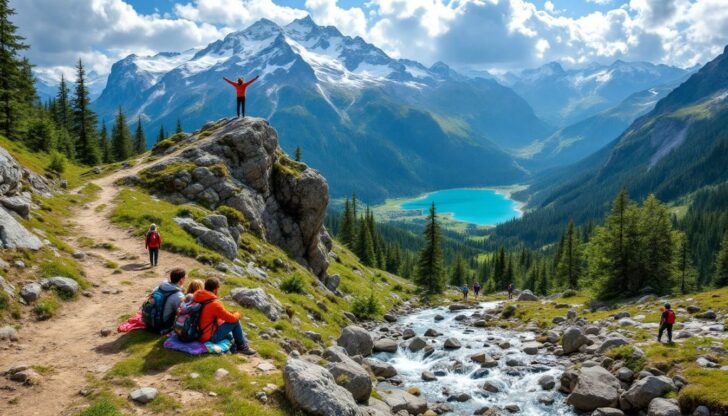The Caucasus Mountains in Russia stretch from the Black Sea to the Caspian Sea. Known for Mount Elbrus, Europe’s highest peak, these mountains boast diverse climates and rich biodiversity. This article explores their geology, major peaks, unique flora and fauna, and cultural history.
Table of Contents
Key Takeaways
The Caucasus Mountains are shaped by complex geological processes, particularly the collision of tectonic plates and the influence of the Alpine geosyncline, contributing to diverse landscapes and significant ecological systems.
The region’s climate varies significantly with elevation, affecting local ecosystems, and supporting a rich biodiversity that includes over 6,400 plant species and 130 mammal species, making it a critical conservation hotspot.
Political and geographical divisions in the Caucasus reflect a complex history of cultural exchange and conflict, with ongoing environmental challenges exacerbated by mining, illegal activities, and overexploitation of natural resources.
Geology and Formation of the Caucasus Mountains

The Caucasus Mountains are a testament to the powerful forces of nature. The collision of the Eurasian and Arabian tectonic plates gave rise to the region’s complex geological structures, evolving through various phases of tectonic activity. These dynamic processes have intricately shaped the mountain range’s rugged terrain over millennia.
A significant geological event in the Caucasus Mountains’ history was the Alpine geosyncline’s influence during the late Mesozoic and Cenozoic eras. The uplift and formation of the mountains, resulting in today’s dramatic landscapes, were driven by this geosyncline. The Greater Caucasus range, in particular, serves as a prominent geological divide between the Black Sea and the Caspian Sea, marking a crucial boundary in the region.
Erosion and sedimentation shaped the Caucasus Mountains, forming distinct valleys and plateaus that enhance the region’s diverse topography. These natural processes have enriched the region’s geology, making the Caucasus a captivating subject for geologists and adventurers.
Major Peaks and Ranges

The Caucasus Mountains are renowned for their towering peaks, with the Greater Caucasus range hosting some of the highest elevations in Europe. Dominating the landscape is Mount Elbrus, an ancient volcano and the highest peak in the Caucasus, standing tall at 18,510 feet. Its saddle between the twin summits provides a challenging yet rewarding experience for trekkers and climbers from around the world.
The Greater Caucasus mountains span between the Black Sea and the Caspian Sea, creating a significant geographical link between these waters. This range is notable not just for its height but also for its impact on the region’s climate and hydrology. Weather patterns vary between the northern and southern slopes of the Greater Caucasus, contributing to the region’s biodiversity.
Apart from Mount Elbrus, the greater caucasus mountain range includes other prominent peaks such as Dykh-Tau, Shkhara, and Kazbek, each offering unique challenges and breathtaking vistas. These mountain ranges, with their rugged beauty and diverse ecosystems, continue to be a magnet for explorers and nature lovers, making the Caucasus a premier destination for high-altitude adventure.
Climate and Weather Patterns
The climate of the Caucasus Mountains is as varied as its topography. January temperatures in northern Ciscaucasia can range from 23 to 28 °F, whereas the Kolkhida Lowland to the west sees milder winter averages of 40 to 43 °F. The region’s vast elevation range and geographical positioning influence this temperature diversity.
As one ascends, higher elevations in the Greater Caucasus experience significant temperature drops and shorter growing seasons. The southern slopes and northern slopes of the Greater Caucasus receive the highest precipitation, often exceeding 160 inches annually due to prevailing westerly air currents. This heavy rainfall supports lush vegetation and robust ecosystems on these slopes.
Snow cover defines the higher elevations of the Caucasus, lasting four to five months in the southern highlands. The extended snow cover indicates a cold, alpine climate influencing the local flora and fauna. The varied climate across the Caucasus creates diverse environments, each with unique weather patterns and ecological characteristics.
Flora and Fauna of the Caucasus Ecoregion

The Caucasus Mountains boast extraordinary biodiversity. Housing around 6,400 plant species, with over a quarter being endemic, the region is a botanical treasure trove. Seventeen unique plant genera thrive in the Caucasus, with nine adapted to high-altitude ecosystems. This rich plant life supports a wide range of animal species and contributes to the region’s ecological diversity.
Approximately 130 mammal species, including nearly 20 endemic varieties, find a haven in the Caucasus. Endangered bird species like the marbled duck and lesser white-fronted goose find refuge in the Caucasus. Reptilian inhabitants like the endangered Caucasian viper, known for its medicinal venom properties, reside here.
The Caucasus also boasts more than 125 species of freshwater fish, with about a dozen being endemic. The diverse climates of the Greater and Lesser Caucasus ranges contribute to this ecological richness, marking the region as a critical conservation hotspot. The unique flora and fauna blend makes the Caucasus Ecoregion vital for biodiversity preservation and scientific study.
Learn more, checkout Caucasus Mountains in Georgia: Discover the Beauty of …
Human History and Cultural Significance
The Caucasus Mountains’ long history of human habitation and cultural exchange underscores their strategic and cultural importance. Renowned as one of the earliest centers of bronze production, the region’s metallurgical activities date back to the 2nd millennium BCE. Ancient historians like Herodotus and Strabo documented the diverse indigenous peoples of the Caucasus, highlighting its long-standing cultural mosaic.
The Caucasus has faced numerous invasions from groups like the Scythians, Alani, and Mongols, each leaving a lasting impact on the region’s cultural landscape. Middle Eastern cultural influences have significantly shaped the area’s languages and religions, creating a rich cultural tapestry. Today, over 50 ethnic groups inhabit the Caucasus, each adding to the region’s unique cultural heritage.
Languages like Georgian, a key Kartvelian family representative, are vital components of this cultural diversity. Human activities have transformed nearly half of the Caucasus biodiversity hotspot, severely impacting native vegetation, especially in floodplain and forest areas. Despite these challenges, the Caucasus’s cultural and historical richness continues to captivate and inspire.
Modern-Day Activities and Attractions

The Caucasus Mountains attract adventure seekers and nature lovers. Summer is peak season for hiking, with regions like Svaneti and Kazbegi in Georgia drawing trekkers globally. The best hiking months in the Caucasus are mid-June to September, offering varied weather conditions and breathtaking landscapes.
National parks like Borjomi-Kharagauli in Georgia and Dilijan in Armenia feature well-marked trails and camping areas, ideal for independent trekking and interacting with local villagers. These parks showcase a mix of beech and oak forests, serene lakes, and stunning vistas, ideal for relaxed hiking and nature exploration.
Winter activities like skiing tours in Georgia are popular in the Caucasus, although heavy snowfall restricts hiking during this season. Unique attractions like mud volcanoes and ancient rock art in Azerbaijan’s Gobustan National Park enhance the region’s allure, making the Caucasus a year-round destination for outdoor activities.
Energy and Mineral Resources
Rich in natural resources, the Caucasus region plays a crucial role in local economies. The mining sector is vital for economic stability, providing significant export earnings and employment opportunities. Minerals extracted from the region include valuable ores and precious metals that are essential for various industries.
Mining activities in the Caucasus contribute to economic growth and significantly impact infrastructure development. The sector creates numerous jobs, supporting local communities and fostering economic resilience. However, balancing economic benefits with environmental sustainability remains a critical challenge.
Sustainable mining practices minimize environmental harm and promote economic growth. Technological advancements like automation and renewable energy can enhance efficiency and safety in mining, reducing the environmental footprint and ensuring the long-term viability of the Caucasus’s natural resources.
Political and Geographical Divisions
The Caucasus’s political and geographical landscape is as complex as its natural terrain. The Greater Caucasus range serves as a significant natural boundary between Europe and Asia, historically bridging cultural exchanges and the spread of ancient Mesopotamian culture. The region is divided into various political entities; the North Caucasus is part of Russia’s Southern Federal District and consists of multiple autonomous republics, including the caucasus proper.
The North Caucasus houses republics like Chechnya, Dagestan, Ingushetia, and North Ossetia-Alania, each with its unique administrative structure and cultural identity. A blend of cultural influences, including those from the Ottoman Empire and Russian expansion, has shaped these autonomous republics. The integration of the North Caucasus into the Russian Federation after the Caucasian War in the 19th century marked a significant political shift in the region.
The region has been a site of conflict and unrest, particularly with militant activities related to the Caucasus Emirate and the Islamic State. Despite these challenges, central asia remains a crucial geopolitical area, reflecting a rich tapestry of cultural and historical influences that shape its identity.
Environmental Challenges and Conservation Efforts
The Caucasus faces significant environmental challenges, particularly due to mining and illegal activities. Mining can cause severe environmental issues, including ecosystem destruction and heavy metal contamination. Soviet-era mining has left many hazardous sites, requiring extensive rehabilitation efforts. Effective public policy is essential to foster sustainable mining practices and encourage community participation in monitoring environmental impacts.
Illegal logging and fuelwood harvesting significantly threaten the region’s forests. Armenia, for example, lost 27,000 hectares of forest reserves between 1992 and 1995 due to these activities. Overgrazing affects a third of pasturelands in the Caucasus, contributing to erosion and reduced species diversity. Economic crises have driven the illegal wildlife trade, leading to significant overhunting of game species and rare animals.
Overfishing in the Caspian Sea, particularly for sturgeon, poses a long-term threat to fish populations due to their slow maturation. Infrastructure developments like roads and dams disrupt natural habitats, exacerbating habitat loss across the Caucasus. Addressing these environmental challenges requires sustainable practices, technological advancements, and robust conservation efforts to preserve the region’s unique biodiversity.
Summary
The Caucasus Mountains, with their rich geological history, towering peaks, diverse climates, and vibrant ecosystems, offer an unparalleled experience for explorers and nature enthusiasts. The region’s human history and cultural significance add depth to its allure, while modern-day attractions provide endless opportunities for adventure and discovery. However, the challenges of environmental degradation and the need for sustainable practices highlight the importance of conservation efforts.
In conclusion, the Caucasus Mountains remain a vital natural and cultural treasure. By understanding their complexities, appreciating their beauty, and addressing the challenges they face, we can ensure that future generations continue to be inspired by this remarkable region. Whether you are an intrepid explorer, a history buff, or a nature lover, the Caucasus Mountains beckon with their timeless charm and enduring mystery.
Frequently Asked Questions
What is the highest peak in the Caucasus Mountains?
The highest peak in the Caucasus Mountains is Mount Elbrus, reaching an elevation of 18,510 feet. This majestic mountain is a prominent feature of the region.
When is the best time to hike in the Caucasus?
The best time to hike in the Caucasus is from mid-June to September, when the weather is most conducive to outdoor activities. This period typically offers favorable conditions for trekking enthusiasts.
How many plant species are found in the Caucasus region?
The Caucasus region boasts around 6,500 plant species, of which about 25% are endemic. This diversity underscores the ecological significance of the area.
What are some of the environmental challenges facing the Caucasus?
The Caucasus is confronting significant environmental challenges such as ecosystem destruction from mining, illegal logging, overgrazing, and habitat loss due to infrastructure development. Addressing these issues is crucial for the region’s ecological balance.
Which countries are part of the Caucasus region?
The Caucasus region comprises Armenia, Azerbaijan, Georgia, and parts of southern Russia.









